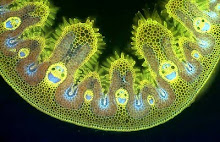I've waited a long time for this. I bought this Strelitzia reginae as a small plant several years ago and made the fundamental mistake of planting it in a large pot, so it's been producing leaves rather than flowers until now. Back in November a flower bud appeared but its growth slowed right down in our unheated conservatory, but April's warmth has brought it into flower
There's no doubt that the Strelitzia bloom is very bird-like. It's also pollinated by birds - sunbirds - in its native South Africa
Hummingbirds in the New World hover in front of flowers and so burn up a lot of energy as they refuel with nectar, but sunbirds have a far more relaxed strategy, using the blue stamen of the flower as a perch
The stamen is a complex structure, formed by two elongated, fused blue petals and tipped with the white pointed stigma. The third blue petal that you can see here at its base is much smaller and conceals the nectar.
When the bird lands on the stamen its weight pushes it downwards, splitting the fused petals longitudinally and exposing the white pollen, which sticks to the bird's feet
When it visits another flower it lands on its stamen and while it's shuffling around probing for nectar it transfers pollen to the pointed white stigmatic surface that you can see above
A new flower rises from the inflorescence spathe every day. This is day two and I'm expecting three more
Image source: http://en.wikipedia.org/wiki/File:Charlotte1767Cotes.jpg
This is a flower deemed fit for a queen and was named by Sir Joseph Banks in honour of Charlotte of Mecklenburg-Strelitz (1744-1818), King George the Third's Queen-Consort, who was an avid botanist and great patron of Kew Gardens.

































